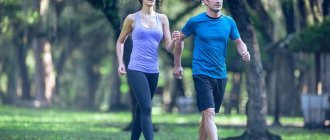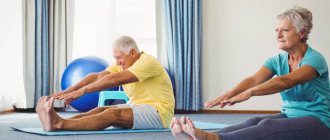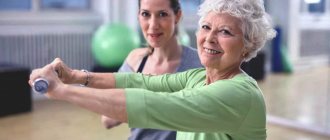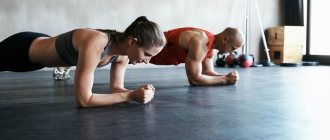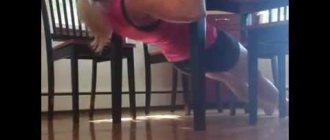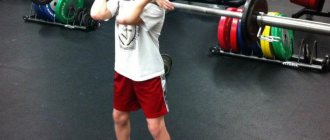Egor Fukalov
fitness trainer
How to build a training program for older people? What exercises are best to avoid?
Each age has its own level of physical activity. It is not recommended to train at the same intensity at 20 and 60 years old. Over the years, the body's recovery slows down, hormonal composition changes and muscle mass is lost.
However, you shouldn’t give up training altogether. On the contrary, physical activity will make life richer and more fulfilling. The main thing is to choose the right set of exercises.
Photo: istockphoto.com
Fitness Curve
We shouldn't think of our fitness in a parabolic format, where we peak in early to middle age and then gradually decline over time. We must try to flatten the second half of the curve to prevent permanent physical decline.
One of the best ways to flatten the curve is through strength training. And this is not someone’s personal opinion, but a scientific fact based on research.
Exercise for 60 years (round for body tone)
The second round of our morning exercises after 60 years includes more intense exercises that will strengthen muscles and joints, develop endurance, burn calories, and awaken from sleep. For example, hip raises, shin curls, side steps, body rotations, arm fly-outs, and arm curls. The class is conducted completely standing; perform the exercises at a comfortable pace.
See also:
- Active morning exercises for losing weight in the stomach: 20 exercises
- Exercises for the back while standing: prevention of scoliosis and osteochondrosis
Walking with high hips
Stand up straight, place your feet next to each other. Bend your arms at your sides. Start walking further in place, raising your hips high as you exhale and bringing your knees above the level of your pelvic bones. Work your hands in opposite directions towards your legs, as when running. Keep your body straight throughout the walk. Take your time, lift one leg and put it back, then the second. Such physical exercise after 60 years will be an excellent way to increase endurance and strengthen the muscles of the legs and buttocks.
How much to do: 16-20 knee raises in total.
Turn the body sideways with your hand
Make the distance between your feet wider, about one and a half shoulder widths, which will give the necessary stability. Place your hands on your waist. The back is straight, legs are straight. Perform the main element: as you exhale, turn your body completely to the left at the same time as you extend your right arm in the same direction and then return to the starting position, repeat the turn to the right. The spine is strengthened, and the exercise provides an effective way to strengthen the back and abdominal muscles.
How much to perform: 10-14 turns in total.
Walking in place with shin overlapping
Return to your normal stance with your feet side by side. Bend your arms at your sides, keeping your elbows at your waist. Straighten your back, straighten your shoulders. Perform the main exercise: start walking in place, alternately doing laps as you exhale. Bring your heels to your buttocks, knees pointing down. Use your hands differently for each step. This exercise is included in morning exercises after 60 years to tone the back of the legs, develop knee joints, and maintain endurance.
How much to do: 16-20 shin wraps in total.
Side step + raise arms
Stay in the position from the previous exercise with your feet together. Keep your back straight, straighten your shoulder girdle. Place your arms down along your sides. To complete the starting position, bend your knees slightly. Now take a step to the right and at the same time, as you exhale, raise your arms up above your head. Then stand in place and repeat to the left side. The muscles of the whole body are toned, joints become stronger. Physical exercise is beneficial for everyone after 60 years.
How much to do: 14-18 arm raises in total.
Body rotations with straight arms
Place your feet one and a half shoulder width apart, keep an even line in your body along the entire length. Raise your arms in front of you to chest level, clasp your hands together, palms facing down. As you exhale, turn your body to the right: your legs and pelvis are static, your arms remain in their original position. Go back and then turn left. The muscles of the trunk and core will be strengthened, as there is an active load on the stomach and lower back. Your posture will improve and your back pain will go away.
How much to perform: 10-12 turns in total.
Knee raises with touching hands
Place your feet shoulder-width apart and straighten up. Bend your arms at your sides. Keep your elbows near your waist, forearms parallel to the floor, palms down. From the accepted positions, begin to walk in place, while exhaling, raising your hips high so that your knees touch your hands in this walk. Do not lean forward, the body is static. Include exercise in morning exercises after 60 years to tone the whole body, with an emphasis on muscles and leg joints. The core is intensively strengthened, especially the lower abdomen.
How much to do: 16-20 knee raises in total.
Step to the side + spread of arms
Bring your feet together and bend your knees slightly. Stretch your arms in front of you at chest level, bend them towards you, and clasp your forearms in front of your face. Install the housing in a straight line. At the same time, take a step to the right and from the accepted position, spread your arms clearly to the sides as you exhale. Stand back up and repeat the step to the left. Make almost no pauses. The muscles of the whole body become toned. The spine becomes stronger, posture improves, and overall endurance increases.
How much to do: 14-18 arm raises in total.
Taking your legs back
Stand behind a chair and place both hands on it. Keep a straight line in your body and tighten your abs. Then, as you exhale, begin to alternately move your right and left legs back, raising them to a moderate height. Don't move suddenly, don't rush. Keep your leg straight, do not bend it at the knee. In terms of effectiveness, one of the best exercises for toning the buttocks and thighs. The exercise is also useful for strengthening the lumbosacral spine.
How much to perform: 12-16 leg abductions in total.
Leg kick + punch
Return your feet to shoulder-width apart and straighten your knees. Hold your arms at your sides like a boxer, elbows tucked in, hands clenched into fists. Straighten your back and chest. This is the starting position. Place your right foot to the side on your toes. Turn your body to the left and, as you exhale, perform a strike with your right hand. Stand back up and immediately repeat both movements in other directions. The muscles of the core, shoulders and arms are strengthened, the legs are toned to the maximum, the joints and spine become more mobile.
How much to perform: 16-20 punches in total.
Bent over arm raises
Place your feet firmly, bend your knees and move your pelvis slightly. Tilt your body forward. Keep your back straight. Straighten your arms along your head, turn your palms towards each other. Direct your gaze downwards. Start from this position by lowering and raising your arms, the amplitude is small. The exercise is useful for the upper half of the body: it strengthens the shoulders, arms, cervical spine, and back. After 60 years of age, it is mandatory to include it in your morning exercises.
How much to do: 8-12 lifts in total.
See also:
- Morning exercises fully standing without a mat: 20 exercises
- Exercises on the bed: 20 static poses to start the day
- Easy exercise for ages 70+ or for very beginners
The Importance of Strength Training for Older Adults
Strength training helps combat many of the things that lead to overall lack of activity, and it also prevents the development of chronic diseases such as diabetes and cardiovascular disease. Strength training will help you maintain balance and mobility longer and help you avoid falls. And at the same time, strength training allows us to stay strong longer, regardless of the natural processes that make us weaker over time.
According to the New York Times, by age 40, many people are losing muscle mass at a rate of about 5 percent per decade, a decline that often results in frailty.
As we lose muscle mass and strength, our risk of death increases. We also see a decrease in power, making simple tasks like getting up from a chair or climbing stairs more difficult.
Due to the natural decrease in bone mineral content, our bones become more fragile over time, increasing the risk of fractures. We also experience a decline in some cognitive abilities such as memory, learning, and processing speed.
Strength training is a powerful weapon against all these natural aging processes.
One study found that adults over 65 who did strength training at least twice a week were 46% less likely to die from any cause than those who did not.
Unfortunately, even with these reasons, less than 10% of adults over the age of 75 engage in strengthening procedures.
What exercises can cause injury?
Jumping with extra weight
When jumping with a barbell or dumbbells, there is an unnecessary compression load on the spine and a shock load on the joints.
Pull-down behind the head
You can injure your shoulder with this exercise. In this position, the shoulder joint receives unnecessary stress.
Overhead press
In this exercise, the humerus is pulled back too far, placing unnatural stress on the joint. Additionally, you create unnecessary pressure on the spine.
Plank for more than two minutes
During the exercise, eye and cranial pressure increases. Vessels and capillaries are pinched, muscles receive less blood and oxygen.
Hanging Leg Raise
If the technique is incorrect, there is flexion at the hip joint, where the main load is taken by the iliopsoas muscles, and not by the abs. After a series of approaches with incorrect technique, your lower back may hurt.
Photo: istockphoto.com
Strength training for seniors
We present to your attention general recommendations that older people should adhere to when performing strength training:
- Sets – Perform 1-3 sets for a specific muscle group. Beginners should start with one approach, gradually increasing their number to 2-3;
- Executions – 8-12 or 10-15. To begin with, try doing 3-12 repetitions of one exercise, later move on to 10-15.
- Load 70-85%. You should start with a load that you can lift, gradually increasing to 70-85% of your own weight. But if you have heart disease or osteoporosis, you should not use such a large load.
- Types of exercises – 8-10 different exercises. You should perform exercises that target different muscle groups.
- Equipment – You can use free weights or machines. For beginners, it is preferable to start with exercise machines; later, as your form improves, you can move on to exercises with free weights.
- Regularity – 2-3 times a week for each muscle group.
- Explosive strength training - 40-60% of your own weight. The amount of weight used directly depends on the current muscle strength, stretch, parameters and functional tasks.
- Functional training allows you to practice the movements that we perform in everyday life. In old age, you need to devote enough time to this type of training, because it involves many joints and allows you to keep your body active.
The presence of chronic diseases should also be taken into account before starting training. 85% of older people have at least one chronic disease (osteoporosis, arthritis, diabetes, mild cognitive impairment), so they need to adapt the load to their needs and capabilities.
So, at what age is it too late to start strength training? The answer is simple: such an age does not exist. With the right approach, after a medical examination and drawing up a program, you can train at absolutely any age.
Of course, you won't be able to do what 25-year-olds do and that's completely normal. Almost any type of physical activity is beneficial for older adults, but strength training offers unique benefits that can make you live longer and happier.
What scientists say
You can gain muscle mass even if you have reached middle age (from 40 to 60 years old) or beyond it.
Marcas Bamman
Director of the Center for Exercise Medicine at the University of Alabama at Birmingham
Our laboratory and others have repeatedly shown that older people's muscles also grow and become stronger.
As part of the study Exercise dosing to retain resistance training adaptations in young and older adults, which was conducted by Bamman, men and women aged 60–70 engaged in strength training. Their muscle development occurred at the same rate as that of 40-year-olds.
But the process of muscle growth differs between young and old people.
Skeletal muscles are made up of different types of fibers. When we reach middle age, two types of changes occur.
Marcas Bamman
Some fibers die, especially if the muscles are not exercised. Sedentary adults lose 30 to 40% of their total muscle fibers by age 80. The remaining fibers shrink and atrophy with age. If we exercise, the size of atrophied muscle fibers increases, but not their number.
It turns out that despite training, your number of muscle fibers will not increase. However, the atrophied fibers will start working and increase in size, so the muscles will still become bigger and stronger.
When to Stop Exercise Immediately
Remember - classes are aimed at bringing you pleasure, the load should be feasible and comfortable. It is important to closely monitor your well-being and your body’s response to exercise.
Stop exercising immediately and seek medical advice if you experience the following symptoms:
- when performing the exercise you feel severe pain and aches;
- during or after exercise you notice an excessive increase in heart rate, chest pressure, changes in blood pressure, you feel dizzy or your blood vessels are pulsating;
- during exercise you find it difficult to breathe, there is nausea;
- you feel very tired after gymnastics, there is a feeling of tension, you want to lie down.
Properly organized activities should give you additional energy and improve your overall well-being. If you observe the opposite effect, you should contact a specialist to understand the reasons and adjust the content of physical activity.
Causes of muscle pain
The causes of muscle atrophy in older people can vary. Pain appears not only due to concomitant diseases, but also due to the aging of the body. With age, the functioning of all systems deteriorates. This happens gradually. A blood test is used for accurate diagnosis. After 70 years of age, it is recommended to undergo regular testing to confirm or rule out polymyalgia rheumatoidia. When the disease occurs, severe pain in the shoulders is observed. Also, ailments are possible with diabetes mellitus and thyroid problems.
Pain appears after taking statins used to lower cholesterol. Also, ailments can be triggered by stress.
Who shouldn't be active in sports?
Some diseases still do not allow you to actively engage in sports. Among them:
- acute myocardial infarction
- active endocarditis
- heart failure
- acute aortic dissection
- heart block
- recent stroke
- aortic stenosis
- tachyarrhythmia
- transient ischemic attack
Contraindications
Sports activities that involve intense physical activity have a number of restrictions. It is not recommended to ignore existing contraindications, because the consequences may be negative.
At the age of 60, it is recommended to completely abandon increased physical activity if you have the following health problems:
- recent traumatic brain injury;
- epilepsy;
- malignant neoplasms;
- spinal injuries;
- heart attack;
- pathologies of the heart muscle.
Physical therapy, the program of which is selected by a specialist, may be permitted for some diseases.
After 60 years of age, men should temporarily stop training if their general health deteriorates until the cause of the unpleasant symptoms is determined.
You should reduce the intensity of exercise or completely abandon sports during periods of exacerbation of chronic diseases, colds, flu, etc.
Who should play sports first?
Physical activity is necessary for everyone. Even if you are partially immobilized or have no strength for sports, you can keep your muscles toned with outside help.
However, doctors especially advise those who have:
- obesity,
- depression,
- arthritis,
- heart diseases,
- venous stasis,
- insomnia,
- renal failure.
